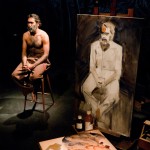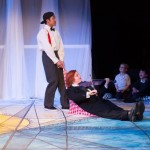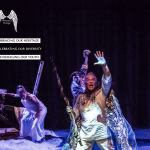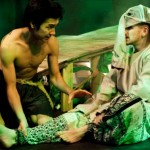- Director, Ian Nicholson
- Researchers Simon Day (with the collaboration of Aitor Basauri)
- Devising cast: Dennis Herdman, Merce Ribot and Patricia Rodriguez
- Writer and Adapter, Tiffany Wood
As I viewed The Knight of the Sorrowful Figure on Tuesday 21st May but I felt considerable misgivings with its most basic issues of form and content. I offer my views without prejudice and hope they are helpful in continuing to develop the work.
The most important thing I want to communicate is that I wasn’t any more clearer at the end of the show why you had chosen such an iconic work as Don Quixote other than to use the work to say ‘the Spanish are a passionate people’. The problem for me was that as an audience member who has experienced Cervantes’s masterpiece in so many different forms – novel, film, original play [Rocinante, Rocinante] – it was impossible for me to accept the novel could be reduced on the simple pantomime plot which was presented in your play. The metatheatrical devices seemed little more than the slapstick of clowns who were on a quest to nowhere because, as you know in modern pantomime, the narrative is just an excuse to string together the physical and verbal antics.
I have no problem about satirising the ‘literary canon’, but in order to create the provocatively profane I believe you first have to acknowledge what’s sacred in the first place. I could see no evidence from what I saw that the team had done this in what was performed.
Why do you suppose the story of Don Quixote has been influential for over 400 years? The ‘Q & A’ session addressed everything but this key consideration. As a theatrical device to grab the audience it had promise but I believe it took the audience away from knowing anything about your grapplings with a 400 year old story that still exists in the popular imagination. That’s got to make your work futile in the wrong sense. You had an opportunity to take on a giant of literature but it seem to me that first of all you needed to see the gargantuan proportions of its legacy in the first place. The research shows for instance, that Cervantes had a deliberate purpose for his book[1]
…it would seem that Cervantes wrote his novel solely for literary purposes, in order to destroy a literary genre; it would be a caricature of a man whose brain has been infected with the virus caught from reading such romances as Lancelot, Tristan, Palmerin, Belianis etc., – of which an autodafe is arranged in chapter VI.
Now it has been the general trend among critics (including that poet-critic Unamuno) to brush aside, as of no central significance for our novel, the critical program proclaimed by the author of the Quijot: derribar la máquina of the romances of escapism. After all, they argue, the centuries-old fashion of these romances had reached its height a century before Don Quijote, and was already in its decline by 1560; how they should Cerbantes have been impelled to attack its influence in 1605? Or, even if this was his initial purpose, it was soon lost sight of, as the novel gradually developed beyond its original didactic scope, growing in breadth, and vision and humanity.
But I beg to disagree: too much has Cervantes, in the preface written at the completion of the First Part, and on the last page of the whole book, insisted on his literary program. And if the critics have been so eager to disregard his expressly-stated purpose, in favour of one supposedly more closely allied to human nature and life, it has been, perhaps, because they have failed to grasp the magnitude of this purpose, and the human problem implied therein. For what Cervantes did was to POSIT THE PROBLEM OF THE BOOK[2], and of its influence on life – a problem that has developed in the course of the last centuries, a problem as challenging today as it was to Cervantes. He was the first to grasp the proportions of this problem….
What is the benefit of taking on the importance of Cervantes in your work?
Consider Tom Stoppard’s Rosencrantz and Guildenstern Are Dead. Look at the way he grows the play out of the Shakespeare’s Hamlet. It is now a masterpiece in its own right as it resonates the dramatic tension and structure of the original source. I see no reason why Cervantes cannot offer you the same creative achievement as Shakespeare did for Stoppard.






